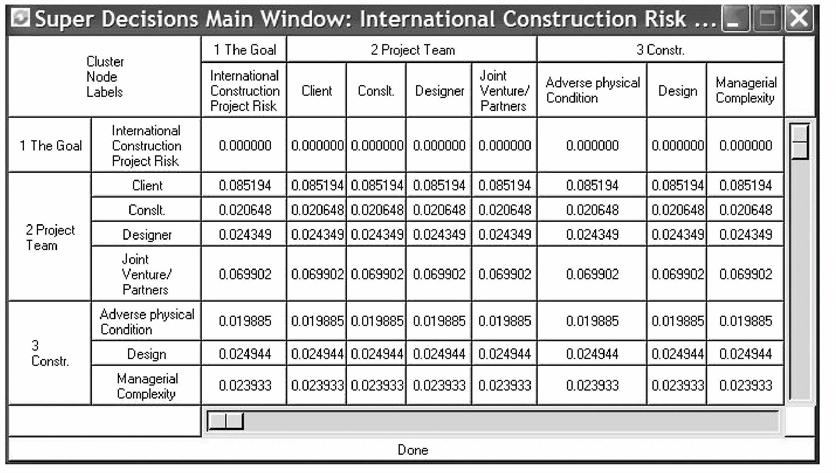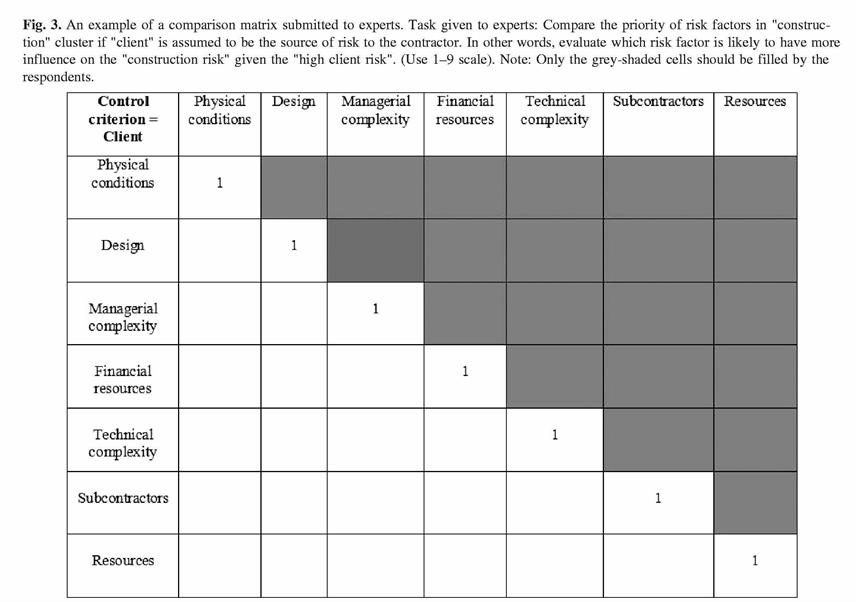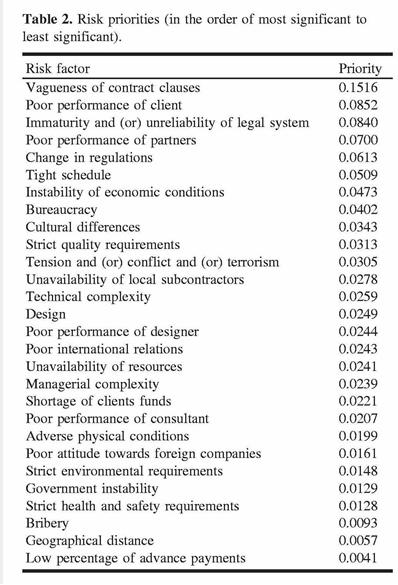Introduction
Assessing risk in construction projects is probably one of the most vital aspects of international construction project management. According to Yildiz, assessing risk in the construction project is very complex because they are few tools and guidelines that exist to help contractors with capital budgeting (147). The construction industry involves many players who carry out various functions throughout the lifetime of the project. However, although this industry is very lucrative, it has many players and competition is very stiff. This industry is unique in the sense that individual practices cannot influence decision-making.
The industry has been propelled by continuous demand for new infrastructure and real estates with modern designs in the emerging market. Moreover, international construction projects have increased notably due to the high demand for new infrastructure in developing countries. Most of the developing countries are seeking international contractors to help them sustain and develop new real estate and national infrastructure development projects such as roads and railways.
Most of these countries are seeking international help from Asia, the US and the Russian Federation. Due to the high demand for construction projects in the emerging market, it has led to the development of international agreements, which has introduced radical changes in this industry. For instance, it has resulted in the development of the North America Free Trade Agreement and “Uruguay Round”. International capital projects are complex to assess due to the limited resources in a diverse set of economic, environmental, cultural and geographical risks. When foreign contractors are assigned construction projects, they have to consider the risk involved in the project such as pricing and scheduling. Although contractors agree there are many risks involved in international projects, there is no consensus on the real risk and reward of these projects. This paper analysis risks assessment strategies in facility construction, which has a broad range of risks.
Literature review
International construction risk management is a well-studied subject. In this literature review, we shall try to identify and give a basic concept of risk management. This literature review defines risk and provides a snapshot of the case study. Moreover, it establishes risk management strategies that can be applied in facility construction. Facility construction has a lot of risk exposures. In this literature review, we shall define an international construction project to mean a contractor from a different country to that of the host project. It is complex to assess the risk in these projects because it involves a wide range of issues including those of new jurisdictions that may have many interjects of unknown risks.
The risks involved in facility construction vary significantly from one geographical region to the other. Usually, an international contractor finds it difficult to operate in a different jurisdiction due to new rules and regulations. These international facilities construction projects differ from domestic work in terms of the technology needed, risk assessment techniques and construction style. The success of facility construction is affected by the contractor’s understanding of risk and uncertainty. Historically, United States contractors have dominated the industry. Specifically, US contractors have a long history of successful overseas construction.
Recently, US contractors have started facing stiff competition from Chinese firms. Although international projects are very lucrative, they are elevated to a high level of risk. The assessment of this project also has proven to be complex due to the uncertainty of new geographical operations. These international construction firms can only be able to deliver successful facility projects if they have a comprehensive understanding of the political, constructional and environmental risks. However, assessing the risks associated with facility construction is difficult because few management tools can enable them to measure the risks.
Different approaches to defining risk
The definition of risk is not new especially because it is well studied in logistical chain management. The thematic of risk in supply chain management can be traced back to 2003. Risks are present in international construction projects, which include logistics, where the presence of the risk can affect the entire network. Thus, it becomes imperative for managers to identify and manage risks. The definition and understanding of risk differ from one person to another depending on their attitude, viewpoint, and experience, which make it complex to define risk. However, Shou and Aguria identified a basic risk theory centered on selected reviews for 20 years and presented his definition to the Oxford English Dictionary (246).
Ave argues that risk follows the environment revolution, which was the rationale they relied on when identifying the relationship and influence it has on risk communication and decision-makers. According to Eybpoosh and Birgonul, designers and contractors view risk from the technology perspective (1172). However, developers view risk from the financial viewpoint. Therefore, the question that we ask ourselves is: what is a risk? Risk can be defined from a different perspective.
For instance, one definition of risk is the probability that an event will unfavorably affect the organization or the outcome. Dongping and Mingen argued that risk is an intrinsic property in a decision, which can be measured by a mixture of several critical factors such as exposure and occurrence (864). However, the risk is limited to the severity and frequency of occurrence of a potentially harmful event because of exposure. Risk is also defined by the British Occupational Health and Safety Assessment as the likelihood of an adverse event causing harm to the organization.
Therefore, the whole concept of risk can be answered in two simple questions; what the probability that an event that involves exposure will occur and cause harm to a project? 2 how harmful can be the exposure if it occurs? Risk can also be defined as the uncertainty of an event, which can occur due to exposure and cause severe consequences on a project. The table below shows some definitions of risk.
According to Hastak and Shaked, a risk is a chance that a project or activity will be adversely affected an exposure; in this case, the threat means any potential source of harm that may cause damages (59). Risk can be expressed in terms of probability. Thus, we can summarize by arguing that risk is a probabilistic event that can adversely affect the outcome of a project. While it would be naive to assume that all contractors and practitioners agree on the definition of risk, they all agree there is a need to develop strategies to minimize the impact and likelihood of adverse events from affecting a project.
Thus, it is important to use risk management as an avenue through which international contraction companies can be able to assess the likelihood of a threat. Furthermore, it should enable managers to maximize new opportunities to achieve set objectives.
Although practitioners do not agree on the definition of risk, they have agreed that there is a need to include opportunities in the traditional definition of risk. Thus, for this paper, we shall take the traditional definition of risk. Moreover, this study will give more weight to the sources of risk that have a detrimental impact on predefined construction projects. Therefore, the risks are seen as a threat to construction projects. Although opportunities in construction projects are not an aim of this study, no integral risk management strategy can succeed without taking into account opportunities. Before developing a risk assessment process, it is essential to establish the risks that are likely to affect a project. Furthermore, a risk assessment should be considered before developing a risk breakdown structure.
Methods of assessing risk
From the literature above, we can identify the inclusive process in international construction risk assessment. We shall determine risk assessment methodologies by examining several models associated with international construction projects. Finally, this study shall review risk management and assessment techniques.
Before the international construction company enters the market, it should analyze potential risks and opportunities in the market. This will help them to be able to assess the potential risk that may be detrimental to the business. The net worth changes in the emerging markets are presenting new opportunities for international construction companies to expand their business operation in other geographical locations.
Moreover, even local construction companies are beginning to pursue the international construction market. Due to the need to assess the risks associated with international construction projects, different methodologies have been developed to help them in risk management. For instance, Kikmen and Birgonul proposed that international construction risks can be assessed by identifying and quantifying the risks of the project based on the country and the project status (63). The proposal was aimed at utilizing a fuzzy risk-rating model that would help them to calculate the cost overrun risk. They have argued that four decisions must be made to assess international construction companies. The technique and the decision category were based on the four factors;
- Internationalization decisions; before an international construction company accepts an offer, they should first assess if they have the capability and the expertise to complete the project in that geographical location. This should be carried out before accepting the offer to conduct business in the international market. After assessing this decision, construction companies should undergo an environmental scanning to identify if there are adequate resources to complete to project.
- Market selection: after a construction company has assessed the decision to join the international market, they should select the market that is reliable and offers an opportunity for future expansion. This can be done using a SWOT analysis.
- Bid/no-bid decision: it can also be referred to as project selection. The contract should decide whether to apply/bid for the project or not. When reaching this decision, the contractor must take into account the attractiveness of the project and the availability of resources. This should be done by assessing the expected profitability of the project in the long run. At this point, it is imperative to determine the level of risk exposure by assessing the risk expected and future returns. This is crucial because it influences the overall attractiveness of a project and its profitability. As a rule, international construction companies should reject projects with a high level of risk.
- Bid price decision: after deciding to bid on a project, the contractor must be able to determine the markup price of the bid. The price of the bid is assessed based on the probability of winning and expected profitability.
This model can be referred to as demonstrating internationalization decisions. El-Sayegh and Mansour argued that a compounded approach of AHP coupled with the Delphi model can be used to assess international construction projects when reaching decisions regarding future expansion (7). The authors also proposed an international decision model that can be used to support market selection decisions. This model can assist international contractors to make decisions regarding both internal and external readiness tests. Moreover, it can help to determine the attractiveness of a country and in choosing the most appropriate entry mode.
International construction projects can also assess risks using ISO 31000 (Dikmen and Han 501). ISO 31000 refers to international principles and guidelines, which provide a framework and a process for managing risk. International construction companies can apply this framework to assess the risk associated with a particular project before deciding to bid for the project. This framework helps international construction companies to increase their chances of achieving their objectives. Moreover, it also helps contractors to improve identification of risk, opportunities, and threats which assist them to make decisions regarding allocating scarce resources.
However, ISO 31000 cannot be applied to certify risk, but can only be used as a guideline for internal and external audit programs. Therefore, international construction companies should use this model of risk management by comparing it with internationally recognized benchmarks to provide effective corporate governance.
International construction companies can also apply the EPR model (COSO) to assess the risk exposure in international construction projects. Enterprise risk management gives contractors a remarkable opportunity to achieve a robust view of potential risks that can affect the success of international construction projects. COSO has enabled construction companies to be able to assess the internal risks facing a project.
Because risk in construction projects keeps evolving every day, contractors must ensure they have reliable information to help them assess risk. Thus, enterprise risk management comes into play by helping construction companies to provide contractors with valuable information about risk exposures that may affect the outcome of a project. Specifically, it helps contractors to assess and manage top risks that are likely to affect a project that can be monitored on an ongoing basis.
Risk management cycle
The risk management cycle is important in construction projects because it enables contractors to minimize risk as they maximize output. It includes the identification of risk, analysis, and evaluation. The first step in risk management is identifying the threat facing construction project. To identify these threats, contractors assess the expertise required to complete the projects. Specifically, the look at their workforce and technology required to complete the project. For instance, if a project requires highly qualified and experienced staff that the organization cannot afford, this is a threat to the project. Thus, contractors will be able to identify the risk before accepting a project.
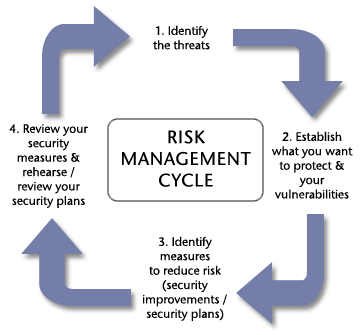
To identify these risks, we can also use the analytical network process. Analytical network tool allows contractors to make multi-criteria decisions. For instance, it helps them in project planning, selection, performance prediction, and project scheduling. It is used to measure the relative priority of individual judgment that belongs to the fundamental scale. These multi-criteria judgments show the influence of one element in a project over the other. Analytical network tool compares an element to their respective importance toward their control as shown below.
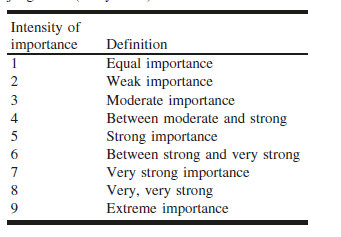
The risk factor shows the exposures that may negatively affect a project and its objectives. Therefore, in this analysis, the risk is perceived as a threat, where the overall risk level is composed of various factors that differ in magnitude. The risks are assessed and managed depending on the magnitude and their ability to determine the future outcome. The rating denotes the level of risk in a given international construction project. Moreover, it shows the probability that a risk factor will negatively affect business. This model is based on risk identification, risk analysis, and risk evaluation.
Risk identification
Risk identification is the process of establishing a risk that affects a given international construction project. Risk identification is perhaps one of the most crucial aspects of risk management because it tries to establish the type and level of risk. It involves the identification of potential risks and attempts to clarify the risk responsibility in a construction project. When identifying risk, contractors determine which risk affects a project and their characteristics are documented. For instance, the technology required in a construction project can help contractors to identify potential risk.
If the company cannot afford the technology or does not have the expertise to use that technology, there is a probability it will affect the project in the future. This way, managers can be able to identify risks before they affect a project. It develops the basis of risk analysis and risk evaluation. If contractors can be able to identify risks, they will be able to manage them effectively (Choi and Seo 263). Various checklist and risk structure breakdown can be used to identify risks in a construction project. In our study, we shall use an in-depth risk analysis breakdown structure that has been identified by experts in construction projects. This breakdown shows the main challenges facing global contractors as they try to determine risks in international construction projects. It is reflected in a hierarchical risk breakdown below.
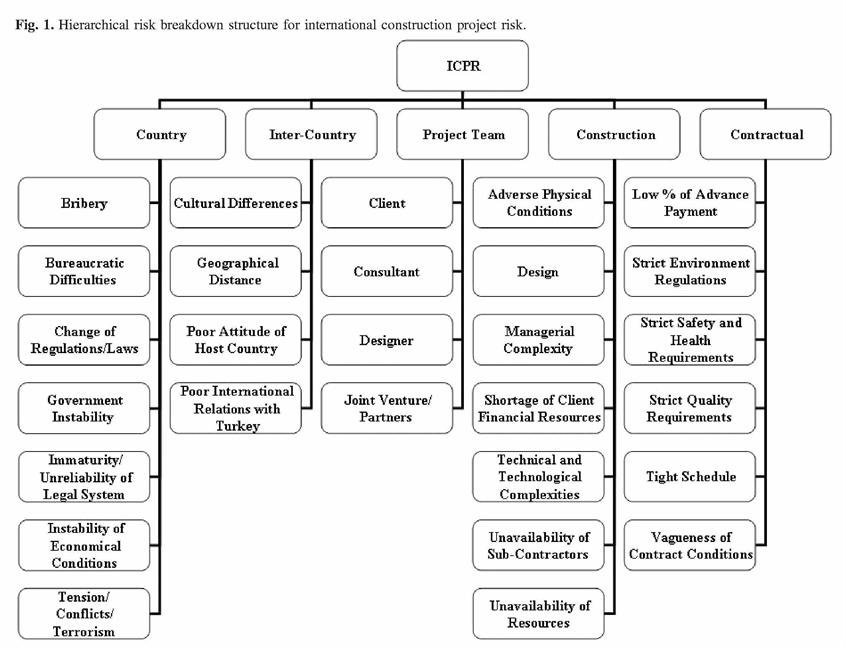
The risk identification process is provided in unstructured data that make it very difficult to create a conceptual model. Risks are identified based on their priority and their impact on a project. The hierarchical structure above is constructed on three levels of risk identification. The first level shows the aim of identification; establishing the risk source associated with construction projects. The second level shows the criteria used to identify risk and it’s significant to the project. Finally, the third level shows the risk levels that fall on each category. Although the structure above shows how risk can be identified in international construction projects, it does not define isolated clusters that show the best category for representing risks.
Risk analysis and management
Risk analysis is imperative in construction project management because it helps contractors and assesses threats that can jeopardize a project. Risk analysis enables contractors to identify the level of risk facing a particular project. It can be carried out using various techniques. However, the application of these techniques is usually supported by other analyzing tools that can be automated. These techniques can either be qualitative or quantitative which can be associated with semi-quantitative and simulation methods (Bu-Qammaz and Birgonul 1172).
However, qualitative subcategory does not involve numerical data. Information is presented in the form of description, results, and recommendation. The risk analysis is connected with a qualitative scale to identify the probability and impact it has on a project. The risk is analyzed in conceptual terms based on risk tolerance. This risk analysis can be identified as high, low, or medium as shown in the tables below.
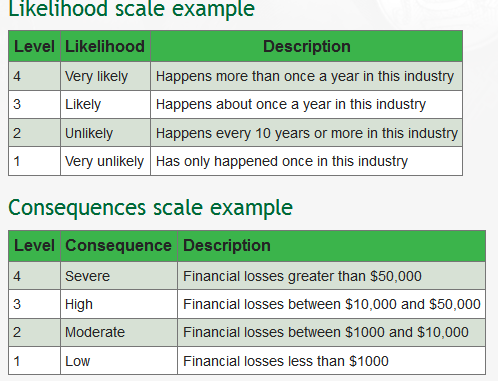
Risk can be analyzed qualitatively using techniques such as brainstorming. A decision tree can be employed as a qualitative technique that can help contractors to identify risk in uncertain projects. For instance, contractors can use a decision tree to identify the possibility of a project failing to meet its intended objective.
Risk evaluation
After identifying and analyzing the risk, it is essential to identify how likely the harm will affect international construction projects. Since risk is a daily occurrence, contractors should know ways of controlling the risk responsibility. Risk evaluation refers to the balancing of risk against real measures such as money and time. However, a contractor should establish whether it affects the internal or external factors of a project. Moreover, the risk evaluation technique should be proportional to the level of risk. Both internal and external risks can be evaluated by establishing a rating table. It means identifying the severity of a risk and how it can be managed as shown in the risk table below.
Risk assessment template
Conclusion
Risk assessment in a construction project is very complex because there are few tools and guidelines that exist to help contractors with risk management. The construction industry involves many diverse players who carry out various functions throughout the lifetime of the project. International contractor finds it complex to operate in different jurisdictions because of the nature of the risks involved.
These international facility construction projects differ from domestic work in terms of risk assessment techniques and technology. The changes in the emerging markets have been opening new opportunities for international construction companies to expand their business operation in other geographical locations. Even local construction companies in the US are beginning to pursue the international construction market.
However, the risks involved in this market are higher compared to domestic projects. The success of facility construction is affected by the ability of the contractor to comprehend potential risks affecting a project. These risks are intrinsic property in decision making, which can be measured by a mixture of several critical factors such as exposure and occurrence. For instance, international construction companies can apply the EPR model (COSO) to assess risk exposure. International construction projects can also assess risk exposures using ISO 31000 model that is effective in risk management. It also helps contractors to improve risk identification, opportunities, and threat which assist them to make sound decisions on the allocation of scarce resources. Risk assessment techniques have assisted international contractors to be able to identify, analyze, and manage risks.
Works Cited
Bu-Qammaz, Aguria, and M. Talat Birgonul. “Risk Assessment Of International Construction Projects Using The Analytic Network Process.” Canadian Journal Of Civil Engineering 36.7 (2009): 1170-1181.
Choi, Hyun-Ho, and J. W. Seo. “Risk Assessment Methodology For Underground Construction Projects.” Journal Of Construction Engineering & Management 130.2 (2004): 258-272.
Dikmen, Irem, and Sedat Han. “Using Fuzzy Risk Assessment To Rate Cost Overrun Risk In International Construction Projects.” International Journal Of Project Management 25.5 (2007): 494-505.
Dongping, Fang, and Li Mingen. “Risk Assessment Model Of Tendering For Chinese Building Projects.” Journal Of Construction Engineering & Management 130.6 (2004): 862-868.
El-Sayegh, Sameh M., and Mahmoud H. Mansour. “Risk Assessment And Allocation In Highway Construction Projects In The UAE.” Journal Of Management In Engineering 31.6 (2015): 1-11.
Eybpoosh, Matineh, and Talat Birgonul. “Identification Of Risk Paths In International Construction Projects Using Structural Equation Modeling.” Journal Of Construction Engineering & Management 137.12 (2011): 1164-1175.
Hastak, Makarand, and Aury Shaked. “ICRAM-1: Model For International Construction Risk Assessment.” Journal Of Management In Engineering 16.1 (2000): 59.
Kikmen, Irem, and M. Talat Birgonul. “An Analytic Hierarchy Process Based Model For Risk And Opportunity Assessment Of International Construction Projects.” Canadian Journal Of Civil Engineering 33.1 (2006): 58-68.
Shou, Qing, and Muhammad Aguria. “Risk Management Framework For Construction Projects In Developing Countries.” Construction Management & Economics 22.3 (2004): 237-252.
Yildiz, Ecem. “A Knowledge-Based Risk Mapping Tool For Cost Estimation Of International Construction Projects.” Automation In Construction 43.(2014): 144-155.
Appendix
